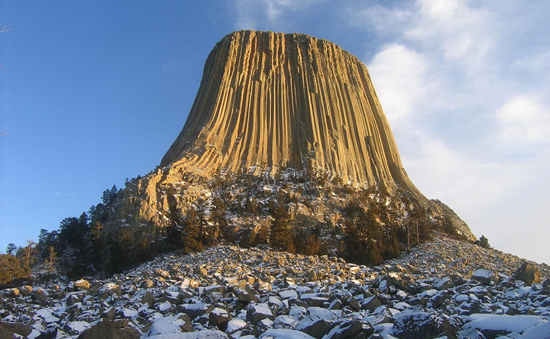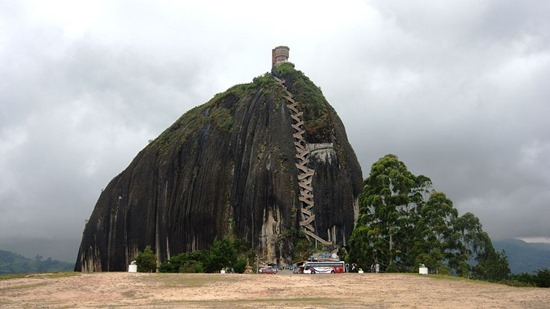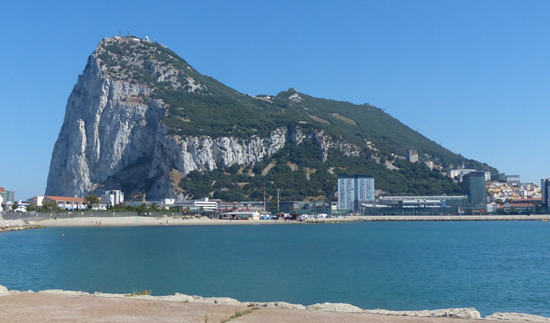
Some of the world's most recognizable natural landmarks are monoliths. Uluru (pictured top) and El Capitan are so well-known that tourists plan their itineraries around them.
These massive stones were formed in prehistoric times by violent eruptions, tectonic shifts or eons of erosion. Some are still surrounded by legends, while others are pilgrimage sites or considered so sacred that it is a sin to set foot on them. All are stunning examples of the kind of architecture that Mother Nature is capable of.
Here are some of the world's most impressive monoliths.
1. Devil's Tower
Devil's Tower in in northeast Wyoming is America's oldest national monument. Theodore Roosevelt gave the two-square-mile area containing the 1,267-foot monolith the designation in 1906. The rock is easily distinguished from other famous formations because of the grooved texture of its sheer sides and its flat summit. According to Native American lore, the unique texture was created when a giant bear ran its claws down the rock.
Experienced climbers do try to scale the peak. However, because the climb is extremely challenging, most visitors enjoy the view from ground level. There are trails that loop around the base of Devil's Tower that offer views of the famous monolith and also provide a glimpse into the nature and wildlife in the surrounding landscapes.
2. Stone Mountain
Georgia's Stone Mountain is a granite monolith standing 800 feet above the surrounding surface and 1,600 feet above sea level. In addition to being more than five miles in circumference, it is well known for its location - only a short drive from Atlanta - and also for the large relief carving depicting Confederate figures from the Civil War era: Jefferson Davis, Stonewall Jackson and Robert E. Lee.
The carving, which is approximately three acres across, has been a subject of controversy, with some people calling for the image to be removed completely. Even so, the mountain itself remains a popular attraction. There are several trails to the summit, and those who do not want to climb can take a Swiss-made tram to the top.
3. Sigiriya
One of the most well-known sites in Sri Lanka, Sigiriya is a granite monolith that rises above the jungle in the center of the island nation. The sides of the rock are nearly vertical, and people who climb to the flattened summit must navigate a series of stairs that are not for the faint of heart. The views from this nature-made tower are tremendous (as long as you do not suffer from vertigo), but the real attractions are the remnants of an ancient civilization that visitors encounter during the climb.
The most captivating relics are frescoes that date back to the 5th century. The mountain also includes a series of tiled staircases and ancient gardens. Historians say that the monolith was site of a fortress in the 5th century by a powerful Sri Lankan king. These military structures were subsequently turned into a Buddhist monastery.
4. Uluru
Uluru, a huge sandstone monolith in the Northern Territory's Uluru-Kata Tjuta National Park, is, aside from the Sydney Opera House, the landmark most associated with Australia. The rock's summit stands 1,142 feet above the surrounding desert (and almost 3,000 feet above sea level). It is known by two names: Uluru, the official Aboriginal title, and Ayers Rock, after Colonial-era politician Sir Henry Ayers.
Some people come specifically to climb the rock. There is a chain railing to aid those who make the half-mile ascent, but it is still dangerous, especially when the winds are high. Climbing has long been a controversial issue because Uluru is considered sacred by the native Anangu people, and they have asked visitors not to set foot on it. The rock is visible from viewing points in the park, and there is a collection of luxury camps and lodges that sit within eyeshot of the famous formation.
5. El Peñon de Guatape
This monolith in Colombia sits near the town of Guatape in an area of Colombia defined by a large hydroelectric dam. The native Tahamies people worshiped the large stone, which was first climbed in the 1950s. To make the ascent easier, hundreds of wooden steps were built into a large crack on El Peñon. The easier climb eventually made it a tourist attraction.
Visitors make the two hour trip from Medellin to climb to the summit, where they can purchase souvenirs and enjoy the view of the nearby dam complex from a three-story lookout tower. The area was actually not dammed until the 1970s. It was prime farmland before that and local farmers thought that the rock was a nuisance, not an asset, because it blocked them from creating easily-plowable fields.
6. Zuma Rock
Zuma Rock rises 2,300 feet above the Nigerian countryside at a site about 45 minutes outside of the capital city of Abuja. Even people who have been to Nigeria but never traveled to the capital region have probably seen an image of Zuma because it is pictured on the back of the 100 naira note.
Legends surround Zuma Rock, including one that focuses on a section of the rock wall that looks like a human face with eyes, a nose and a mouth. Local residents claim that the rock has spiritual powers, and many people point to a controversial luxury resort that was once built near the Zuma's face as evidence of this. The unwanted hotel project failed quickly, and the building has now fallen into a state of disrepair. It is possible to climb this monolith, but because there is no infrastructure on the rock itself, a guide and proper climbing equipment are often required.
7. Rock of Gibraltar
The Rock of Gibraltar is a limestone monolith on the Southwestern tip of Iberia. It is part of Gibraltar, an overseas territory of Great Britain. The 1,398-foot peak has long had symbolic significance. For ancient European civilizations, it marked the end of the known world. It was (and remains) very important strategically as the gateway to the Mediterranean.
People climb the rock for several reasons. First, the views include panoramas of Europe, the sea and the African coastline. The rock is also home to a colony of Barbary macaques, who are quite tame (some would say overly so). The peak also features a network of tunnels built by British forces during the 18th century and expanded during World War II. Finally, the rock is home to a Moorish castle that dates back to the 8th century. Part of the well-maintained structure was used as a prison as recently as 2010.
8. Sugarloaf Mountain
Sugarloaf Mountain sits at the mouth of Guanabara Bay in Rio de Janeiro. It gets its name because it is shaped like a sugarloaf, the compacted cone of refined sugar that was favored until the late 19th century. Since 1912, visitors have been traveling to this iconic Brazilian monolith, which stands 1,299 feet above the water, on a cable car. Since then, more than 37 million sightseers have ridden to the top of the rock.
Sugarloaf is also the center of Rio's vibrant climbing scene. Because of its challenging routes and proximity to the city, it is considered one of the world's best urban climbing destinations. Whether you ride to the summit in a cable car or tackle a challenging climb, the views from Sugarloaf, of the bay and the city, are worth the trip.
9. El Capitan
El Capitan is one of the world's tallest monoliths. It stands 3,000 feet above the floor of Yosemite Valley in Yosemite National Park. There are several viewpoints where people can look up at the impressive rock face. Some of these, such as Inspiration Point, require a hike, and some, like El Capitan Meadow, only require getting out of your car (or merely looking through the windshield).
Because of its height and vertical walls, this monolith is famous in the rock climbing community. El Cap, as it is known to climbers, has a number of different routes, all of which are extremely challenging. The formation has even made its way into popular culture: Apple named a recent version of its operating system "El Capitan," including pictures of the peak as desktop wallpapers.
10. Peña de Bernal
Peña de Bernal stands more than 1,100 feet over the town of San Sebastian Bernal in Central Mexico. The town has become a tourist destination for the rock, and also for its historic charms. San Sebastian has an open air theater, cobblestone streets and an aged church.
Only well-equipped climbers can make it all the way to the monolith's summit. However, there is a trail that goes about halfway up the mountain. There is a small chapel at this point, and local people, who consider the rock sacred, make the hour-long pilgrimage at certain special times during the year.










No comments:
Post a Comment
Please adhere to proper blog etiquette when posting your comments. This blog owner will exercise his absolution discretion in allowing or rejecting any comments that are deemed seditious, defamatory, libelous, racist, vulgar, insulting, and other remarks that exhibit similar characteristics. If you insist on using anonymous comments, please write your name or other IDs at the end of your message.